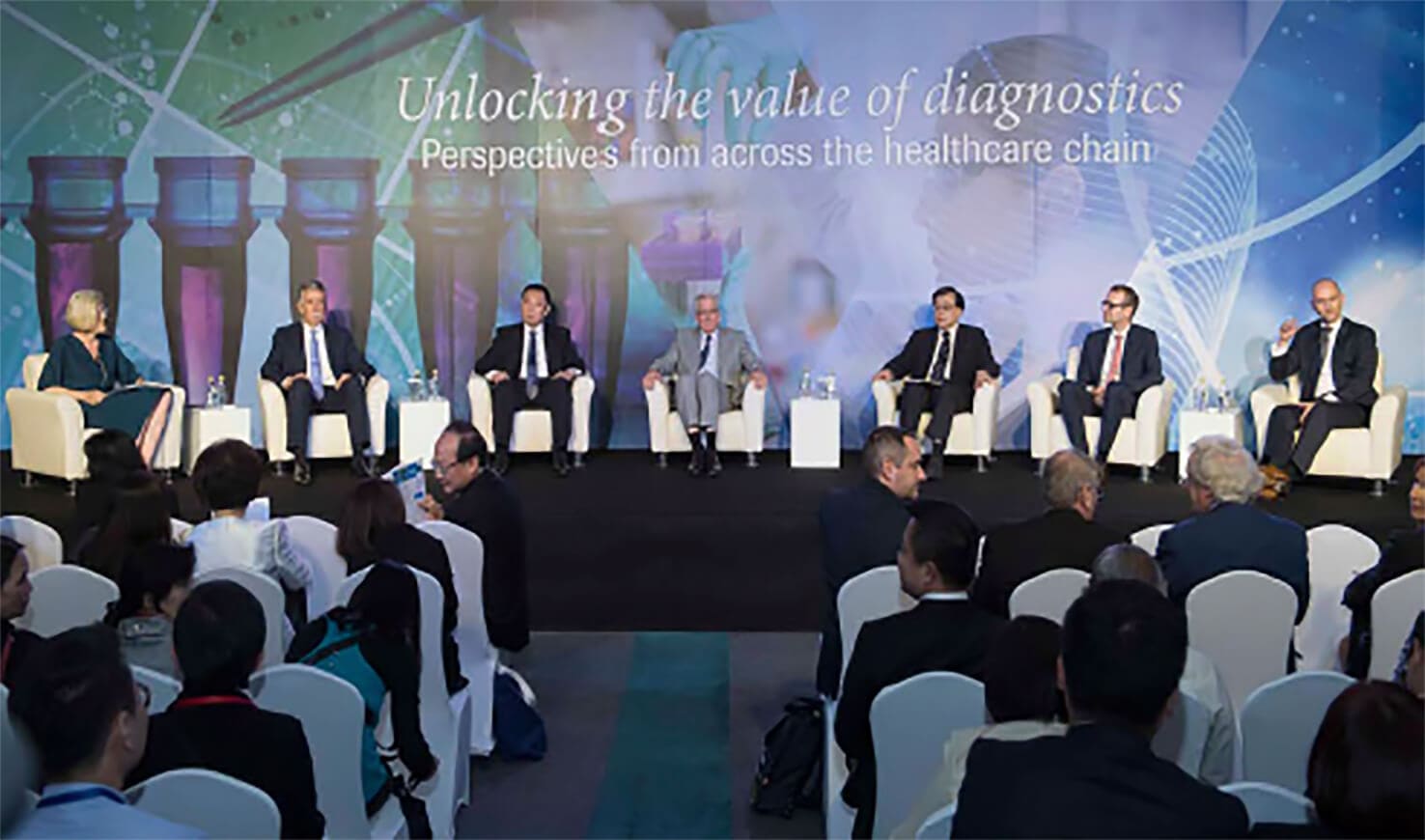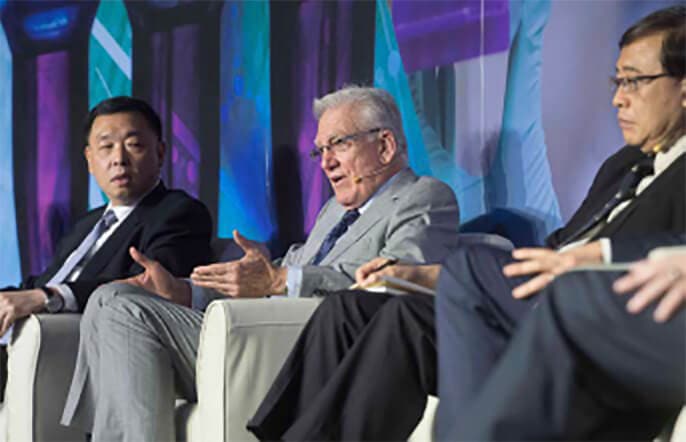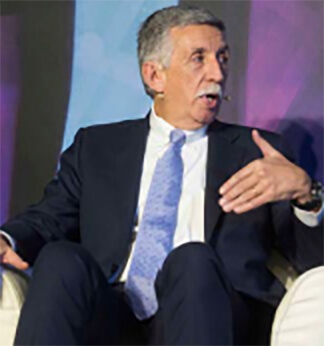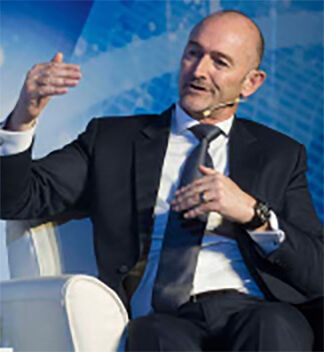Data shows that diagnostics guides over 70% of clinical decision-making but only receives around 2 to 5% of healthcare funding.¹ Diagram magazine reports on a panel discussion in Taiwan which brought together experts from across the healthcare chain to explore ways to collaborate and harness the power of diagnostics for sustainable healthcare.

Diagnostics is the backbone of healthcare, yet current systems and reimbursement models fail to unlock its true value. In order to investigate this problem and facilitate solutions, Roche Diagnostics partnered with the Asia Pacific Federation of Clinical Biochemistry and Laboratory Medicine (APFCB) to organise a panel discussion on the sidelines of the 14th Asia–Pacific Clinical Biochemistry and Laboratory Medicine Congress in 2016. The one-hour discussion brought together six healthcare leaders from the laboratory, industry, insurance and clinical sectors to share their perspectives on the value of diagnostics across the healthcare chain. From addressing what value means to different stakeholders, to identifying barriers in the appropriate use of diagnostics, the panel explored a range of ideas to drive better utilisation of laboratory medicine within the health system.
Defining value
Professor Howard Morris, Professor of Medical Sciences at the University of South Australia and a Clinical Scientist in Chemical Pathology, started the discussion by asking a fundamental question: What is “value” in healthcare? In the case of in vitro diagnostics, he said, value could be defined by how much the test results influenced the pathway of the patient through the healthcare system. “Reducing the length of time that the patient needs to be in the system and consequently, healthcare costs, is where laboratories could have a significant impact,” Prof Morris said.
Take the example of chest pain, a common emergency, accounting for nearly 10% of emergency room consultations.2 Yet, diagnosing a heart attack is one of the most challenging problems faced by doctors in hospital emergency departments. This is because heart attack symptoms can range from chest pain that radiates into the arms, to jaw pain, sweating and nausea. Since these symptoms are not specific, they present additional challenges in the fast and accurate diagnosis of a heart attack.
Currently available blood tests look for elevated levels of certain proteins, including the troponin T protein, which is released during a heart attack. However, these proteins are typically only detectable three hours after a heart attack, when the muscles of the heart have already sustained damage. According to current guidelines, patients with symptoms suggestive of a heart attack, must remain in the hospital for at least three hours before receiving a diagnosis.3 This means that even patients who do not have a heart attack remain in the emergency room, using already strained resources and leading to a hospital bed shortage.
Dr Raphael Twerenbold, MD, Department of Internal Medicine, University Hospital Basel, Switzerland, said high sensitivity troponin T testing can now speed up diagnosis of a heart attack to less than an hour instead of three to six hours. “We found that, along with ruling in a heart attack, we could also rule out a heart attack and allow patients to be discharged much earlier from the emergency department thereby saving costs and ensuring greater efficiency within the healthcare system,” he said. However, new technologies or diagnostic data points are only useful if a physician can put them into context. In reality, the gap between clinical research and clinical practice can be significant, Dr Twerenbold said.
Physicians rely on a few corner stones such as the clinical presentation of the patient and existing tests and tools. Clinicians have to be brought on board to adopt the new technology and shown how it can support their work to improve patients’ outcomes. Without sufficient context, new technologies can cause confusion among clinicians. This is where the diagnostic industry has a key role to play.

Barriers to better use of diagnostics
One major obstacle in the better use of new diagnostic information, as in the case of troponin T, is the view of diagnostics as just a service. Dr Maurizio Ferrari, President of the International Federation of Clinical Chemistry and Laboratory Medicine (IFCC) commented that there is still some work to be done if the laboratory doesn’t want to be viewed like other services within a hospital. “We need laboratorians to see themselves as collaborators and get more involved with the clinicians in the interpretation of the data,” he said.
The speakers recognised that several cultural and subjective factors limited collaborative efforts. Laboratorians can be famously introverted and tend to be siloed which is why a model for collaborative work with the physician would need to be established. As some of the more repetitive functions of laboratories are automated, there is an opportunity for laboratorians to get involved in complex clinical discussions and decision-making based on the subtleties in test results. Laboratorians must understand their evolving position within the healthcare community as it grows from that of diagnostic test service provider to a central player in ensuring quality, prevention, and cost savings for populations, said Dr Ferrari. “This changing role will call for increased collaboration between laboratory professionals and the physician community, and more sophisticated knowledge on the part of the laboratorian on how diagnostic prevention impacts health systems.”

Such impact would also drive funding for tests. Dr David Lu, Deputy Regional Chief Medical Officer & Vice President, Life & Health Products, Swiss Reinsurance Company Ltd, Hong Kong acknowledged that diagnostics is fundamental to insurance. “Without diagnostics, we have no insurance. From assessment of risk, to insurance product design as well as pricing and reimbursement, it is all dependent on diagnostics,” he said.
But with a plethora of new tests and biomarkers on the market, insurers are looking to fund tests that truly affect treatment decisions and outcomes for patients. Tests that provide questionable information, false positives with insufficient specificity and sensitivity all have the potential to distort the insurance market, he said.
Prof Morris said that generating evidence in laboratory medicine remained a difficult task. “Unlike the pharmaceutical industry where significant profits are being made and millions of dollars are spent to prove that a particular drug is effective in treating the disease, the diagnostic industry is simply not able to acquire the funding required to run such studies,” he said.
However, this is starting to change. Lance Little, MD of Roche Diagnostics Asia Pacific, said the clinical efficacy requirements to bring a new test to market were on the upswing. He cited the example of the ATHENA trial – a landmark study of HPV DNA testing efficacy in 47,000 women over seven years4. Results from the study have had a profound influence on clinical practice guidelines for cervical cancer detection5. The data showed that to be clinically useful, a test system had to be validated towards the end point of picking up disease and not just an HPV infection. This is important for cervical screening programmes as HPV infections are extremely common among young women. Only assays whose clinical sensitivity and specificity for pre-cancer lesions are validated in a properly designed prospective study would yield the kind of early detection, risk stratification and appropriate treatment targets that can save lives while reducing the costs of treating disease detected at a later stage.
As healthcare models across the world shift their emphasis from volumes to value, the speakers agreed that the academic rigour involved in large trials along with the clinical validation of diagnostic tests can raise their profile. “When patient outcomes are the basis for reimbursement, laboratory medicine specialists will need to articulate the value they bring,” Prof Morris said.
Adding to this notion of value, Dr Lu talked about the role of diagnostics experts in contextualising the value that advances in personalised medicine and companion diagnostics would bring to patient care. “The value of a data point that would help the physician choose the right treatment for the patient would definitely control downstream costs. It would also help modernise the insurance packages as they are not designed with the latest diagnostics tests in mind,” he said.

Breaking silos to unlock value
The speakers then discussed strategies to realise the value of diagnostics. Dr Aw Tar Choon, Senior Consultant, Laboratory Medicine, Changi General Hospital, Singapore, said a key but often ignored area is the removal of unnecessary or unimportant tests. “It is easy to add on tests to a panel but unusual to remove them. For instance, we reviewed the data from full cardiac panels for an entire year and realised that the older markers were not providing any additional benefit,” he said.
Another key issue is the place laboratory medicine occupies within medical education curricula. Dr Aw cited a study that showed the average amount of time spent in the curriculum on anatomy and physiology ranges from 16 to 300 hours. “But the median time spent on laboratory medicine, which includes most of the diagnostic tests that we do, is only eight hours. Of course, the students who then become doctors feel diffident interpreting a laboratory test result,” he added.
Prof Morris said that there were considerable gaps in the way that clinicians and laboratories communicated with each other. “It is largely subjective and often does not work very well. So it is up to professional societies to initiate and enhance clinical collaborations and relationships both at an international and national level.”
Dr Twerenbold said the fastest way for new tests to gain acceptance was to leverage best practice guidelines through international societies. To get maximum acceptance it was crucial to find ways for physicians to integrate the information from the laboratory test into their clinical decision-making. He said the challenging question here was who should tell the physician how to utilise the test results.
“If the industry goes to physicians and organises a talk on how to do it, it would be harder for it to get accepted,” he said. Adding, “the first step was to seek the cooperation of all parties and then channel these innovations through the physician.”

Mr Little agreed that there was a clear opportunity for the industry, scientists, physicians and laboratory medicine experts to come together to interpret diagnostic data in a way that would deliver value. If they missed this opportunity, he warned that the diagnostics industry was in danger of being disrupted by forces from outside the clinical world like Google, Apple and IBM. “There are others who can connect the dots to enable the right people to make the right decisions on behalf of the patient,” he said.
When patient outcomes are the basis for reimbursement, laboratory medicine specialists need to articulate the value they bring.
Dr Aw said, “If laboratory medicine is not to be marginalised, we have to be more proactive in this area. To remain consultable and stay relevant, we must seize all the opportunities available.”
In conclusion, the speakers agreed discussion and dialogue to bring about collaborative models of working were key to ensuring health systems saw the true value of diagnostics. Dr Ferrari said improved communication and sharing of best practices also had a crucial part to play. He said the pathway to such global best practices would need to be generated by the collaborative efforts of each region’s medical community.
“Successful rooting of such practices will be measured by the ability of its healthcare professionals to effectively articulate the new value proposition of diagnostic testing, not only among themselves but to their policy makers, payers, and patient populations,” he said.
References:
¹European Diagnostic Manufacturers Association.
²Rubini Gimenez M, Twerenbold R, Reichlin T, et al. 2014. Eur Heart J; 35: 2303–2311. Direct comparison of high-sensitivity-cardiac troponin I vs. T for the early diagnosis of acute myocardial infarction.
³Holli A. DeVon, Nancy Hogan, et al. 2010. Time to Treatment for Acute Coronary Syndromes: The Cost of Indecision, US National Center for Biotechnology Information.
⁴www.hpv16and18.com/hcp/athena-hpv-clinical-trial/background-study-design.html. Last accessed 10 October 2016.
⁵The American College of Obstetricians and Gynecologists. 2012. ACOG Practice Bulletin. Clinical Management Guidelines for Obstetrician-Gynecologists: Screening for Cervical Cancer.














